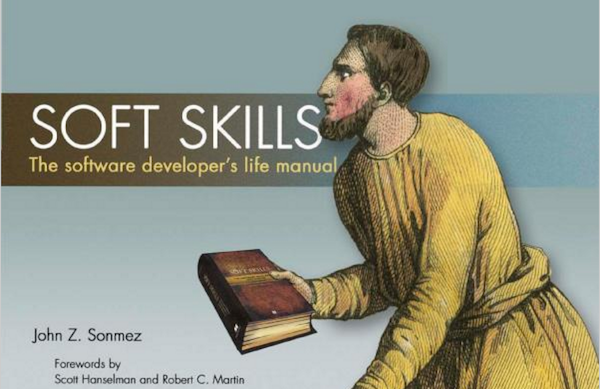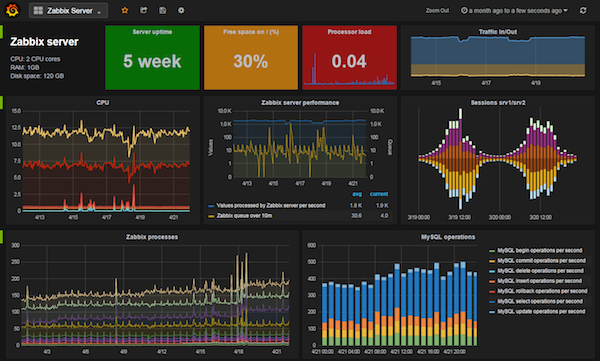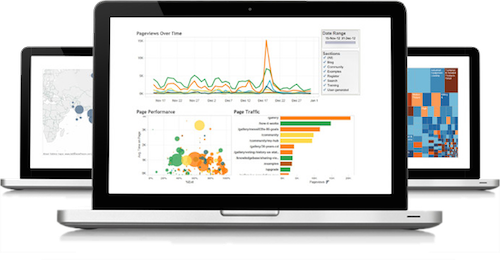
程序员都需要哪些软技能
在某问答网站看到了一个非常很有意思的问题:程序员都需要哪些软技能?前段时间正好看完了一本神书,稍微归纳出一些不成熟的想法:
- 持续学习意愿
- 口头表达和写作能力
- 建立合理预期的能力
- 管理事务复杂度的能力
- 个人品牌建设的能力
- 财务管理能力
下面一一叙述。

When I first saw Grafana, I was astonished by its beauty immediately and I believe it should be the very tools for most dashboard / monitor use cases. This 10,000+ stared project provide a complete solution for metrics and analytics.
Check this live demo and you should feel the same pleasure as I do.
In short, Grafana is a metric solution which include UI Render / Query / Data Source features.
UI Render is amazing; Different types of Queries are supported and it provide a wide range of Data source (mostly time series DB) support.
So, to setup a Grafana for our own use, what should we do?
That’s it!
The following article will cover how to set all the stuff up under Mac OSX. Although we have homebrew and pip, but it take more effort than it seems to be.
First of all, we are going to choose the data source first. Grafana provide a lot of DB support including: Graphite, Elasticsearch, CloudWatch, InfluxDB, OpenTSDB, KairosDB, Prometheus,
I will take Graphite as our primary data source, with the following reasons:

最近看了一些技术项目排雷书,分几个方面总结了一下雷区,以及可以做得更好的地方。

The importance of writing unit tests have been heavily discussed. However, reality is cruel. Many developers do not write UT, and even larger amount of developers write funny tests just to pass the code coverage bar, and some developers with ambition are not quite sure about how to write good unit tests. Most good UT are written by top developers.
I thought I am that kind of ambitious developer, so I spend two weekends to start to learn it. Most cases listed below are originated from or revised from the book “Practical Unit Testing with Testng and Mockito” by Tomek Kaczanowski. A really good book worth reading.
Before we start, let’s visit the concepts of SUT and DOC.

Last weekend I went to play a reality room escape game with some friends. It’s a lot of fun and we finally escape on time!
The only thing make it less perfect is that we skip a “very hard” puzzle according to the staff in the room. We spend 1O minutes on it and we could not found an effective way to solve it.
The game is consisted of a board with 5 rows * 5 columns = 25 lights. Each light is either on or off. Player could switch any light on/off, but switching any light will also switch it’s neighbour on up/down/left/right position at the same time. The goal of this game is for a given status, try to switch some of the lights to make all the lights on.
You could also refer to this graph for the “switch logic”.

To win the game, For example, if the initial status looks like the following board (O mean an enlighted light and X mean an off light), then we could switch 2 lights on (2,1) and (4,3) to make all the light on. But is there an systematic way to get a solution?

In the past 2 years, I spent about 70% of my working time to build, to break, and to fix data products. This article is a brief retrospect of my understanding on building the whole systems, as well as what kind of tools could be plugged as components.
We use data to understand reality and improve our product. This is the primary goal of a data/metric system. A good data system answers question, a better data system identifies root causes, and an even better data system help improve the whole system directly.
In Yahoo!, the data platform I am working on mainly support a Personalization System (Recommendation system). During the iteration of the recom system, we follow and forecast what would be the actual use cases for the team to understand or to improve the Recom system. The major use cases for our system includes:
For different stage, we focus on different aspect and use different tools / techniques to solve problems. Let me illustrate.

过年约了几个兄弟姐妹去玩桌游,大师Neo带了几个桌游过来,玩了一回合菲力猫,人到齐了以后玩了两局,,有赢有输,超级好玩。
总结一下玩了几盘以后的经验:

My boss told me that my goal in this quarter is to working on Continuous Integration for our current product, and all of a sudden I think there’s a lot of gap between the goal and my current skill. The first thing came into my mind is that: “Ohhh, I am still not quite familiar with Git”. After a short period of panic, I sit down to learn about git. And here’s my note.
If you think you could learn git with manual after you learn how to branch, commit and merge, then you might probably be dispointted. Git is very flexible but it do something in a more novel way, so certain understanding of it’s internal is necessary for mastering it, and would be helpful when you look for help in manual. For example, I hear about so many terms such as “HEAD”, “Index”, “Ref”, “Staging Area”, but I could not tell exactly what is that, and I don’t even know how git works. After some diving, I wrapped something very basic in this post.